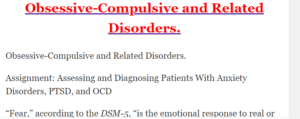Obsessive-Compulsive and Related Disorders.
Obsessive-Compulsive and Related Disorders.
Obsessive-Compulsive and Related Disorders.
Assignment: Assessing and Diagnosing Patients With Anxiety Disorders, PTSD, and OCD
“Fear,” according to the DSM-5, “is the emotional response to real or perceived imminent threat, whereas anxiety is anticipation of future threat” (APA, 2013). All anxiety disorders contain some degree of fear or anxiety symptoms (often in combination with avoidant behaviors), although their causes and severity differ. Trauma-related disorders may also, but not necessarily, contain fear and anxiety symptoms, but their primary distinguishing criterion is exposure to a traumatic event. Trauma can occur at any point in life. It might not surprise you to discover that traumatic events are likely to have a greater effect on children than on adults. Early-life traumatic experiences, such as childhood sexual abuse, may influence the physiology of the developing brain. Later in life, there is a chronic hyperarousal of the stress response, making the individual vulnerable to further stress and stress-related disease.

Photo Credit: Hill Street Studios / Blend Images / Getty Images
For this Assignment, you practice assessing and diagnosing patients with anxiety disorders, PTSD, and OCD. Review the DSM-5 criteria for the disorders within these classifications before you get started, as you will be asked to justify your differential diagnosis with DSM-5 criteria.
To Prepare:
- Review this week’s Learning Resources and consider the insights they provide about assessing and diagnosing anxiety, obsessive-compulsive, and trauma- and stressor-related disorders.
- Download the Comprehensive Psychiatric Evaluation Template, which you will use to complete this Assignment. Also review the Comprehensive Psychiatric Evaluation Exemplar to see an example of a completed evaluation document.
- By Day 1 of this week, select a specific video case study to use for this Assignment from the Video Case Selections choices in the Learning Resources. View your assigned video case and review the additional data for the case in the “Case History Reports” document, keeping the requirements of the evaluation template in mind.
- Consider what history would be necessary to collect from this patient.
- Consider what interview questions you would need to ask this patient.
- Identify at least three possible differential diagnoses for the patient.
By Day 7 of Week 4
Complete and submit your Comprehensive Psychiatric Evaluation, including your differential diagnosis and critical-thinking process to formulate primary diagnosis.
Incorporate the following into your responses in the template:
- Subjective: What details did the patient provide regarding their chief complaint and symptomology to derive your differential diagnosis? What is the duration and severity of their symptoms? How are their symptoms impacting their functioning in life?
- Objective: What observations did you make during the psychiatric assessment?
- Assessment: Discuss the patient’s mental status examination results. What were your differential diagnoses? Provide a minimum of three possible diagnoses with supporting evidence, listed in order from highest priority to lowest priority. Compare the DSM-5 diagnostic criteria for each differential diagnosis and explain what DSM-5 criteria rules out the differential diagnosis to find an accurate diagnosis. Explain the critical-thinking process that led you to the primary diagnosis you selected. Include pertinent positives and pertinent negatives for the specific patient case.
- Reflection notes: What would you do differently with this client if you could conduct the session over? Also include in your reflection a discussion related to legal/ethical considerations (demonstrate critical thinking beyond confidentiality and consent for treatment!), health promotion and disease prevention taking into consideration patient factors (such as age, ethnic group, etc.), PMH, and other risk factors (e.g., socioeconomic, cultural background, etc.).
Learning Resources
Required Readings (click to expand/reduce)
American Psychiatric Association. (2013). Anxiety disorders. In Diagnostic and statistical manual of mental disorders (5th ed.). Arlington, VA: Author. doi:10.1176/appi.books.9780890425596.dsm05
American Psychiatric Association. (2013). Obsessive compulsive and related disorders. In Diagnostic and statistical manual of mental disorders (5th ed.). Arlington, VA: Author. doi:10.1176/appi.books.9780890425596.dsm06
American Psychiatric Association. (2013). Trauma- and stressor-related disorders. In Diagnostic and statistical manual of mental disorders (5th ed.). Arlington, VA: Author. doi:10.1176/appi.books.9780890425596.dsm07
Sadock, B. J., Sadock, V. A., and Ruiz, P. (2015). Kaplan & Sadock’s synopsis of psychiatry (11th ed.). Wolters Kluwer.
Chapter 9, Anxiety Disorders
Chapter 10, Obsessive-Compulsive and Related Disorders
Chapter 11, Trauma- and Stressor-Related Disorders
Chapter 31.11 Trauma-Stressor Related Disorders in Children
Chapter 31.13 Anxiety Disorders in Infancy, Childhood, and Adolescence
Chapter 31.14 Obsessive-Compulsive Disorder in Childhood and Adolescence
Document: Comprehensive Psychiatric Evaluation Template
Document: Comprehensive Psychiatric Evaluation Exemplar
Required Media (click to expand/reduce)
Classroom Productions. (Producer). (2015). Anxiety disorders [Video]. Walden University.
Classroom Productions. (Producer). (2012). The neurobiology of anxiety [Video]. Walden University.
Classroom Productions. (Producer). (2015). Obsessive-compulsive disorders [Video]. Walden University.
Classroom Productions. (Producer). (2015). Trauma, PTSD, and Trauma-Informed Care [Video]. Walden University.
MedEasy. (2017). Anxiety, OCD, PTSD and related psychiatric disorders | USMLE & COMLEX [Video]. YouTube. https://www.youtube.com/watch?v=-BwzQF9DTlY
https://premiernursingpapers.com/2023/01/05/obsessive-compulsive-and-related-disorders/
Use the following coupon code :
premiernursingpapers



